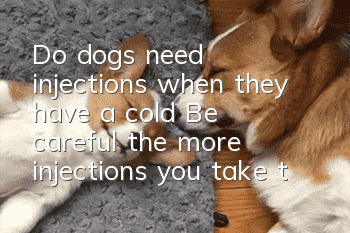Do dogs need injections when they have a cold? Be careful, the more injections you take, the worse your health will be.

Do not take injections if your dog has mild cold symptoms
Dogs who receive frequent injections are prone to produce antibodies. When the dog is in low energy, likes to lie down, has watery nose, sneezing, coughing, loss of appetite, dry nose and fever, etc. When symptoms are mild, you can feed pets special cold medicine, such as Gan Ke Ling. Various oral liquids against cold viruses, take 1 tube a day, 2 times a day. "Amoxicillin" can also be taken orally. A pet dog weighing 10 kg should take about 100 mg. According to this ratio, it should be taken 2 to 3 times a day for one week. During this period, drink more chicken soup without salt, which has a miraculous effect on colds. You can feed some radish, ginger soup, brown sugar tea appropriately, eat less salt, and mix some honey in dog food to reduce inflammation. Massage the nose and the whole body more often to promote blood circulation and ventilation, which will be helpful to the treatment.Send your dog to the doctor if you have a serious cold
1. Once the dog’s body temperature exceeds 40 degrees Celsius, you need to use antipyretic analgesics, such as Analgesics. It can also be injected according to the size of the dog, and the dosage can be controlled at 0.5-2 ml/kg. It can also be treated with traditional Chinese medicine, such as Bupleurum injection.2. If the dog has a watery nose, shakes its head, and keeps sneezing, it is recommended to inject about 0.5 ml (5 mg) of chlorpheniramine subcutaneously. For those with rough wheezing, vesicular sounds or severe coughing, 2 to 5 mg of dexamethasone can be injected intramuscularly. Generally, when this happens, it means that the dog's symptoms are serious, and it is recommended to send it to the doctor as soon as possible to avoid delaying the condition.
3. To combat concurrent infections with other diseases, penicillin is the first choice. 400,000 to 800,000 units intramuscularly, twice a day. Other antibacterial drugs such as kanamycin, cephalosporin, ciprofloxacin, ofloxacin, etc. can also be used. For dogs with severe symptoms, infusion should be arranged, using 10% glucose solution, penicillin, dexamethasone, and vitamin C for intravenous infusion.
It is recommended to go to a pet hospital for subcutaneous injection and have it performed by a professional veterinarian to avoid adverse reactions caused by your own mistakes.
Random articles
- How long does it take for a dog to get vaccinated after a cold? What should you pay attention to during this period?
- What to do if your dog has a cold or fever? Don’t panic if you know the treatment methods
- How long should a dog fast after vomiting? The fasting time needs to be determined according to the actual situation.
- Dog vomits white foam, be careful, it is a sign of disease
- Do dogs need to fast if they have diarrhea? How to treat diarrhea?
- Dogs vomit brown viscous liquid. Physiological and pathological reasons must be distinguished.
- Can dogs be vaccinated against colds? Don’t step into these vaccine minefields
- Does a dog need to fast if it vomits? It depends on the situation
- The difference between a dog’s cold and parvovirus. How to tell if your dog has a cold or parvovirus?
- Is it normal for a dog to vomit brown color? What should be done?



